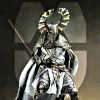Leaderboard
Popular Content
Showing content with the highest reputation on 2014-04-03 in all areas
-
I will put those here. @Zophim (we need complete these) Assyrians: http://es.scribd.com/doc/216009018/Neo-Assyrians-0-3 Autor : Zophim New Kingdom Egypt: https://docs.google.com/document/d/13U8XzkBT6cU5kFB2uzsdAD4tjig8xtxhJDx5PpGrsGE/edit Hitite Etruscan. Phoenicia Mycenaeans2 points
-
Currently, this represents Carthage in 0 A.D. The deity depicted on the symbol is Tanit, a Carthaginian goddess. Although a god such as Melqart would perhaps be a more appropriate thing, there is not anything terribly wrong about Tanit for Carthage. The real problem comes with the Sacred Band. Maybe I am completely off here, but shouldn't a group of warriors dedicated to Baal have him on their shields as opposed to Tanit? Please forgive me if I am out of line with this; clarification on this would be appreciated.1 point
-
I used the corral and cavalry to gather from the sheep trained there for a while in multiplayer, in combination with a rather small number of farms. It was extremely effective after some point in the game, having a huge food income (that constantly booms when you start being able to train bigger and bigger batches of sheep) gathered by just 2-3 cavalrymen. It needed too much attention though, especially in the early to mid game and I couldn't cope so well against most decent players, so soon I reverted back to the lazy ways of only farming. But in long games that you're not under heavy pressure, it should become increasingly superior over farming. As the Mauryans I was able to support huge numbers of food-draining elephants with this strategy while having a bigger army and more spare workers for the needed metal as well. Have in mind that it's function will change though, I believe to something like a steady source of food from each sheep garrisoned in the corral, rather than killing the sheep and gathering from them and it will get balanced afterwards. Edit: Just noticed Lion already mentioned this.1 point
-
Thanks and yeah, I've played a few matches with the AI, loving the historical names for units and so on. :31 point
-
While many people know Javascript, it is not exactly the most liked programming language and for modders still not that easy to grasp. Having an background as an artist, I really like those node-based shader editors (or Blender's somewhat limited logic blocks), which allow you to easily conceptualize the flow of a program visually. Something similar also exists for regular Javascript programming: noFlo: http://noflojs.org/ and they also recently successfully kickstarted their development environment: http://www.kickstarter.com/projects/noflo/noflo-development-environment I think this could be really awesome for modding and given that itself also runs under JS, it should even be possible to integrate it in 0AD. A big strength of such a system is also the shareability of code blocks, which could really kick off modding by vastly lowering the entry barrier for new developers. What you do think?1 point
-
We must always watch out with including "new" stuff in a large code base like 0 A.D.. That new stuff can get abandoned quickly, and our work based on it would be completely lost. Next to that, I don't see how noFlo would help. As our code base is so big, it would be just as difficult to browse through the graph as it is now to browse through the code. And our code blocks are also made as "sharable" as possible, with all extensions that came to our mind in the implementation. So I see no use in it for modding. However, I do see a use of flow-programming when it comes to triggers. The first version of the triggers will be purely code-based. But it should be possible to generate trigger code with an easier interface. Such a flow based interface might work better. Whether noFlo is suited for it or not will have to be researched.1 point
-
Lion rocket. Stanislas sorceror. (my current impression ...) True. That's possible as a prop. Only animations, so no self-thinking units but well, that's already pretty cool. Also, if they are attacked they could automatically switch to the attack animation . Though I don't know if they do damage if they are only a prop (of a building in this case). Supporting Romulus' position, you are doing an awesome job, colleagues. I'm really impressed a lot. Thx.1 point
-
1 point
-
Yes I am ! ^^ So I guess you're the one he told me about. I made those electronic tracks for a friend, but I know this is absolutely not the kind of 0 A.D ^^ I have listened Mr.Lahav's 0 A.D OSTs, to get an idea of what you're looking for. So now the only problem I have is that I don't have any orchestra to play what I do, I can only use software sounds (some of the sounds are sometimes very good ! ). Well, I can play myself and record a few things, or ask someone to play some strings, but I can't have an orchestra... Anyway, I'll try to make something as realistic as I can..1 point
-
http://en.wikipedia.org/wiki/Corporate_identity I know we aren't here to sell and buy products or services, but even the UN have a standar with their logo and colors, they provide a guidelines to how adapts to environment m and how manage media and communication stuff.( my point here is show how manage a logo or a mark or a branding) example Aristeia, or the Council of Modders. --------------------------- Definitions Brand management is a communication function that includes analysis and planning on how that brand is positioned in the market, which target public the brand is targeted at, and maintaining a desired reputation of the brand. Developing a good relationship with target publics is essential for brand management. Tangible elements of brand management include the product itself; look, price, the packaging, etc. The intangible elements are the experience that the consumer takes away from the brand, and also the relationship that they have with that brand. A brand manager would oversee all of these things. Corporate identity. Corporate identity is often viewed as being composed of three parts: Corporate design (logos, uniforms, corporate colours etc.)( not apply to us all)Corporate communication (advertising, public relations, information, etc.)(apply if we in a hypothetical case do it an advertising and merchandising, conference, information about us...etc)Corporate behavior (internal values, norms, etc.)(internal rules)In a recent monograph on Chinese corporate identity (Routledge, 2006), Peter Peverelli, proposes a new definition of corporate identity, based on the general organization theory proposed in his earlier work, in particular Peverelli (2000). This definition regards identity as a result of social interaction: Corporate identity is the way corporate actors (actors who perceive themselves as acting on behalf of the company) emake sense of their company in ongoing social interaction with other actors in a specific context. It includes shared perceptions of reality, ways-to-do-things, etc., and interlocked behaviour. In this process the corporate actors are of equal importance as those others; corporate identity pertains to the company (the group of corporate actors) as well as to the relevant others; Best Practices The following four key brand requirements are critical for a successful corporate identity strategy. Differentiation. In todays highly competitive market, brands need to have a clear differentiation or reason for being. What they represent needs to stand apart from others in order to be noticed, make an impression, and to ultimately be preferred. Relevance. Brands need to connect to what people care about out in the world. To build demand, they need to understand and fulfill the needs and aspirations of their intended audiences. ( our fan base) Coherence. To assure credibility with their audiences, brands must be coherent in what they say and do. All the messages, all the marketing communications, all the brand experiences, and all of the product delivery need to hang together and add up to something meaningful. Esteem. A brand that is differentiated, relevant and coherent is one that is valued by both its internal and external audiences. Esteem is the reputation a brand has earned by executing clearly on both its promised and delivered experience.---------------- now the interesting about create solid logos --------------------------- That my point Visual identity Corporate visual identity plays a significant role in the way an organization presents itself to both internal and external stakeholders. In general terms, a corporate visual identity expresses the values and ambitions of an organization, its business, and its characteristics. Four functions of corporate visual identity can be distinguished. Three of these are aimed at external stakeholders. First, a corporate visual identity provides an organisation with visibility and "recognizability".[3] For virtually all profit and non-profit organisations, it is of vital importance that people know that the organization exists and remember its name and core business at the right time. Second, a corporate visual identity symbolizes an organization for external stakeholders, and, hence, contributes to its image and reputation (Schultz, Hatch and Larsen, 2000). Van den Bosch, De Jong and Elving (2005) explored possible relationships between corporate visual identity and reputation, and concluded that corporate visual identity plays a supportive role in corporate reputations. Third, a corporate visual identity expresses the structure of an organization to its external stakeholders, visualising its coherence as well as the relationships between divisions or units. Olins (1989) is well known for his "corporate identity structure", which consists of three concepts: monolithic brands for companies which have a single brand, identity in which different brands are developed for parts of the organization or for different product lines, and an endorsed identity with different brands which are (visually) connected to each other. Although these concepts introduced by Olins are often presented as the corporate identity structure, they merely provide an indication of the visual presentation of (parts of) the organization. It is therefore better to describe it as a "corporate visual identity structure". A fourth, internal function of corporate visual identity relates to employees' identification with the organization as a whole and/or the specific departments they work for (depending on the corporate visual strategy in this respect). Identification appears to be crucial for employees, and corporate visual identity probably plays a symbolic role in creating such identification. The definition of the corporate visual identity management is: Corporate visual identity management involves the planned maintenance, assessment and development of a corporate visual identity as well as associated tools and support, anticipating developments both inside and outside the organization, and engaging employees in applying it, with the objective of contributing to employees' identification with and appreciation of the organization as well as recognition and appreciation among external stakeholders. Special attention is paid to corporate identity in times of organizational change. Once a new corporate identity is implemented, attention to corporate identity related issues generally tends to decrease. However, corporate identity needs to be managed on a structural basis, to be internalized by the employees and to harmonize with future organizational developments. Efforts to manage the corporate visual identity will result in more consistency and the corporate visual identity management mix should include structural, cultural and strategic aspects.[5] Guidelines, procedures and tools can be summarized as the structural aspects of managing the corporate visual identity. However, as important as the structural aspects may be, they must be complemented by two other types of aspects. Among the cultural aspects of corporate visual identity management, socialization i.e., formal and informal learning processes turned out to influence the consistency of a corporate visual identity. Managers are important as a role model and they can clearly set an example. This implies that they need to be aware of the impact of their behavior, which has an effect on how employees behave. If managers pay attention to the way they convey the identity of their organization, including the use of a corporate visual identity, this will have a positive effect on the attention employees give to the corporate visual identity. Further, it seems to be important that the organization communicates the strategic aspects of the corporate visual identity. Employees(volunteers) need to have knowledge of the corporate visual identity of their organization not only the general reasons for using the corporate visual identity, such as its role in enhancing the visibility and recognizability of the organization, but also aspects of the story behind the corporate visual identity. The story should explain why the design fits the organization and what the design in all of its elements is intended to express. Corporate colours (or company colours) are one of the most instantly recognizable elements of a corporate visual identity and promote a strong non-verbal message on the company's behalf. Examples of corporate colours: Red for Coca-ColaBlue for IBM, nicknamed "Big Blue" Brown for UPS, "What can Brown do for you" Light Teal for Korean AirHistory of importance have a branding or strong graphic identity: Nearly 7,000 years ago, Transylvanian potters inscribed their personal marks on the earthenware they created. If one potter made better pots than another, naturally, his mark held more value than his competitors. Religions created some of the most recognized identity marks: the Christian cross, the Judaic Star of David, and the Islamic crescent moon. In addition, Kings and nobles in medieval times had clothing, armor, flags, shields, tableware, entryways, and manuscript bindings that all bore coats of arms and royal seals. The symbols depicted a lords lineage, aspirations, familial virtues, as well as memoirs to cavalry, infantry, and mercenaries of who they were fighting for on the battlefields.[6] A trademark became a symbol of individuals professional qualifications to perform a particular skill by the 15th century. For example, the Rod of Asclepius on a physician's sign signified that the doctor was a well-trained practitioner of the medical arts. Simple graphics such as the caduceus carried so much socioeconomic and political weight by the 16th century, that government offices were established throughout Europe to register and protect the growing collection of trademarks used by numerous craft guilds.[6] The concept of visually trademarking ones business spread widely during the Industrial Revolution. The shift of business in favor of non-agricultural enterprise caused business, and corporate consciousness, to boom. Logo use became a mainstream part of identification, and over time, it held more power than being a simple identifier. Some logos held more value than others, and served more as assets than symbols.[7] Logos are now the visual identifiers of corporations. They became components of corporate identities by communicating brands and unifying messages. The evolution of symbols went from a way for a king to seal a letter, to how businesses establish their credibility and sell everything from financial services to hamburgers.[7] Therefore, although the specific terms "corporate image" and "brand identity" didnt enter business or design vocabulary until the 1940s, within twenty years they became key elements to business success.[6] -------------------- [the designer tools ] Brand manual A brand guide (or brand manual, standards guide and many other similar phrases) is a document in which describes how to properly convey an entity's brand identity. It usually contains a rundown of the various elements that make up the identity as well as guidelines about how they should be used, and what uses are not allowed. As awareness has grown over the need to use a consistent brand application, brand manuals are today created for more or less all major brands. Many of them are however not available to he public, and are only shared internally. Issues Brand guides tend to include several recurring segments, all involving issues that may face the person who is about to apply the brand identity. Most logos come in more than one variant. The brand manual lays out which variant should be used in which situation. One of the more common problems is what to do with logos that use a designated color. If color printing isn't possible, should one use a grayscale version or a black one? This question gets more advanced if the logo has two colors or more. If, again, color print isn't possible, shuold you use grayscale to distinguish the parts of the logo that have different colors in the full-color version, or should the entire logo be black? As technology has progressed more advanced logos with gradients and bevels have increased in popularity. If one uses such a logo, one may still have to maintain a simpler version to use when high quality print isn't possible. When a logo is seen in its "pure" form it is usually seen against an all white background. When applied it is often possible that the logo will be used against a colored or photographic background, and applying the standard version of the logo isn't always ideal. There are many ways to deal with this issue. Some manuals ban use of the logo against all other backgrounds than white ones. Some allow certain kinds of background, while banning those that upset the logo or makes it hard to see. Many logos have a negative or white version to be used against darker backgrounds, and some provide a special version with white outlines for this purpose. Some logos which include both a symbol and type come in multiple versions with different compositions, including versions with all elements stacked on top of each other or in a horizontal composition. Brand manuals usually enforce a "protective field" of blank space around the logo so it stays separate from other design elements. Boundaries are also set on how creative one can be with the logo outside the brand manual. You are rarely allowed to distort the logo by stretching it, changing to colours, change the composition of logo parts etcetera outside the variaions laid out in the manual. Many manuals also contain guidelines specific to he field in which the logo should be used. This may lay out applications on clothing, on screen, on letter heads, on business cards etcetera. Brand identities increasingly include more graphic elements than just the logo, and these are usually presented in the manual. Many manuals also includes a color palette with approved colors, and guidelines for photography. Sometimes the manual contains material not related design at all, instead describing the brand identity in words that the identity should aspire to fulfill. Examples : Ubuntu. http://design.canonical.com/brand/1.%20Ubuntu%20brand%20introduction.pdf http://design.canonical.com/brand/2.%20Ubuntu%20brandmark%20and%20circle%20of%20friends.pdf Isotype (International System of TYpographic Picture Education) is a method of showing social, technological, biological and historical connections in pictorial form. It was first known as the Vienna Method of Pictorial Statistics In design a isotope is a image that can be the logo itself or part of it. This one most importance of this, protect our logo from incorrect use. http://design.canonical.com/brand/6.%20Ubuntu%20type%20styles%20and%20formats.pdf Even use a corporative typography or fonts. Conclusion. Conclusion In the creation of your brand bible, think of how it will be used. This document is a reference material and guide for how the company should be portrayed to the public. Include examples and specifics. Keep the guidelines direct and simple but also think about how restricting they can be. Guidelines that are too strict can limit creativity and new designs; guidelines that are too loose may result in multiple or disjointed brand identities. Use your brand bible as starting point and establish a culture around it that allows designers room for creative thought while maintaining the aura of the brand in a variety of projects. Remember the ultimate goal of the book is to create a distinct and unified presence for your brand.1 point
-
It's like a several collection of building like with other. May be the coins are given in the temple and they make them in that little building place.1 point
-
http://www.monedasdelbajoimperio.com/2011/07/la-fabricacion-de-monedas-romanas-y-el.html This is Spanish but have the mint tools from roman era. I was knew mint in Spanish is ceca(always I thought the coinage was in house of coin) . Now can be easily find. Somebody speak other language to add more information.1 point
-
I just want to let everybody know that thanks to Stanislas69 and Hephaestion we finally have a working armature in blender compatible with the current unit meshes. Thank you guys! I'll be posting soon a blend file with a basic IK rig for everyone who wants to make new animations.1 point

.thumb.png.ce58cea22940c255f5b0a735d5abee36.png)




